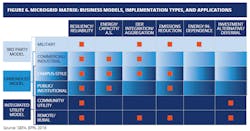Three Microgrid Business Models Emerge from Evolving Market
Not one, but three microgrid business models are emerging as more players enter the market and use microgrids to help realize the grid of the future.
That’s the underlying message of a report issued today by the Electric Power Research Institute (EPRI) and the Solar Electric Power Alliance (SEPA).
“A diverse set of utility and other business models are emerging that support microgrid development and reflect the shifting landscape of generation and delivery services,” says “Expanding Applications, Implementations and Business Structures.”
Until recently microgrids tended to be installed for single customers by private third parties. Now utilities are increasingly getting into the game.
At times, this has caused some elbowing for position between the competitive players and utilities. But it’s also leading to a new, third microgrid business model, the partnering of utilities and private microgrid developers.
These ‘unbundled microgrids’ may vary in terms of which partner owns, operates and finances the project, but they all mark a collaboration between utilities and private entities.
The report points to a 2-MW project in Rutland, Vermont as an example of an unbundled microgrid business model. Vermont’s largest utility, Green Mountain Power (GMP), partnered with independent generation company NRG Energy to develop Stafford Hill microgrid, which uses solar plus storage. The project made the news last summer when it saved GMP $200,000 through a single hour of peak reduction.
Three microgrid models have emerged: 1) third-party microgrid 2) unbundled microgrid 3) integrated utility microgrid.
A microgrid’s ability to reduce demand on the grid is just one of the drivers spurring their adoption. Microgrids are also becoming more attractive because the distributed energy resources that they rely on – such as solar and energy storage – are falling in price, the report says.
The report also cited such drivers as environmental concerns, society’s growing reliance on reliable electricity, integration of renewables, increasing microgrid controller sophistication and public policy and consumer demand. Utilities also are developing microgrids as an alternative to more costly infrastructure upgrades.
Microgrids outpacing regulation
The rise of more complex microgrid business models underscores gaps where technology has outpaced government regulation.
“Developing supportive price signals, tariff structures, and regulations for DERs [distributed energy resources] and microgrids at large is a necessary ingredient for the technology’s uptake,” says the report.
Who pays for what can be a problem, especially for a microgrid designed to offer unmonetized social benefits. For example, in some cases community microgrids not only keep power on for their customers during an outage, but also serve as a place for others in the community to travel for shelter, fuel cars, buy food, or charge phones.
“How should these costs be allocated to a utility’s rate base? Should customers outside the installation have to pay to reinforce hardware that does not ultimately connect to their meters? What if no widespread outage occurs and the microgrid never islands?” says the report.
Who owns what also can cause headaches. For example, in cases where the utility does not own the generation, “when these microgrids island, a third party sells power to end users, a practice that may violate the utility compact in some jurisdictions,” says the report.
Other challenges the report cites as the microgrid industry grows include:
- Uncertain environmental policy and incentives for renewables
- Uncertainty about future fuel prices, particularly for natural gas-fired combined heat and power
- Shifting market price signals and constructs for real-time, day-ahead, capacity and ancillary services markets, and in vertically integrated markets, utility marginal costs.
Track news about emerging microgrid business models by subscribing to the Microgrid Knowledge newsletter. It’s free.
About the Author
Elisa Wood
Editor-in-Chief
Elisa Wood is the editor and founder of EnergyChangemakers.com. She is co-founder and former editor of Microgrid Knowledge.
